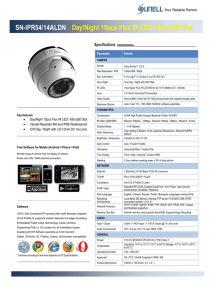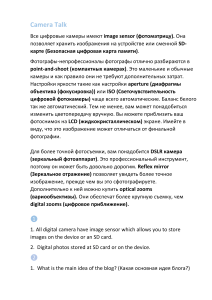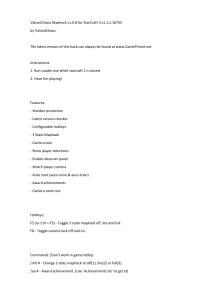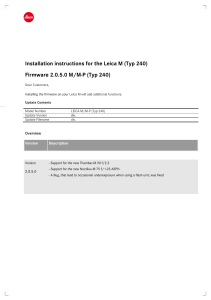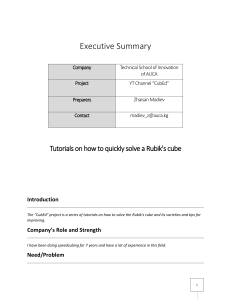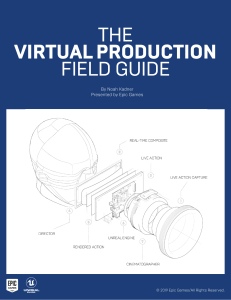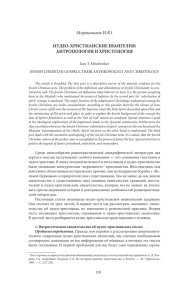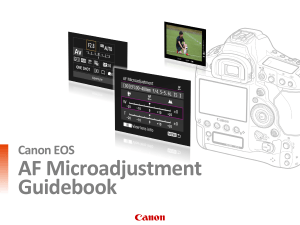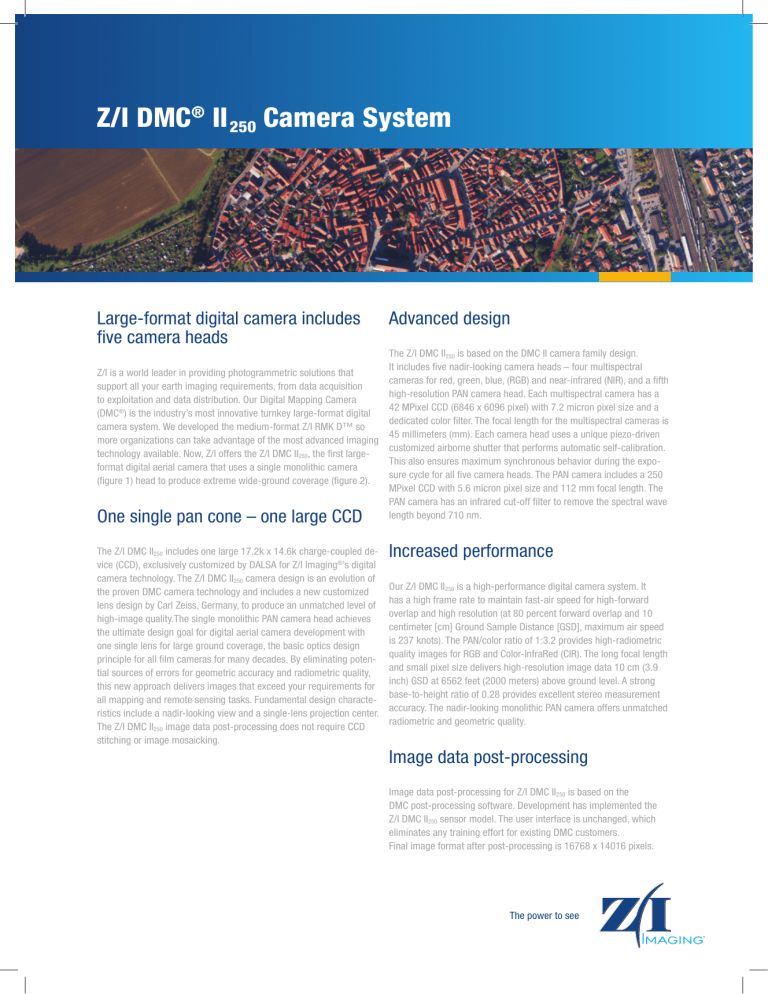
Z/I DMC® II 250 Camera System Large-format digital camera includes five camera heads Advanced design The Z/I DMC II250 is based on the DMC II camera family design. It includes five nadir-looking camera heads – four multispectral Z/I is a world leader in providing photogrammetric solutions that cameras for red, green, blue, (RGB) and near-infrared (NIR), and a fifth support all your earth imaging requirements, from data acquisition high-resolution PAN camera head. Each multispectral camera has a to exploitation and data distribution. Our Digital Mapping Camera 42 MPixel CCD (6846 x 6096 pixel) with 7.2 micron pixel size and a ® (DMC ) is the industry’s most innovative turnkey large-format digital dedicated color filter. The focal length for the multispectral cameras is camera system. We developed the medium-format Z/I RMK D™ so 45 millimeters (mm). Each camera head uses a unique piezo-driven more organizations can take advantage of the most advanced imaging customized airborne shutter that performs automatic self-calibration. technology available. Now, Z/I offers the Z/I DMC II250, the first largeThis also ensures maximum synchronous behavior during the expoformat digital aerial camera that uses a single monolithic camera sure cycle for all five camera heads. The PAN camera includes a 250 (figure 1) head to produce extreme wide-ground coverage (figure 2). MPixel CCD with 5.6 micron pixel size and 112 mm focal length. The PAN camera has an infrared cut-off filter to remove the spectral wave length beyond 710 nm. One single pan cone – one large CCD The Z/I DMC II250 includes one large 17.2k x 14.6k charge-coupled device (CCD), exclusively customized by DALSA for Z/I Imaging®’s digital camera technology. The Z/I DMC II250 camera design is an evolution of the proven DMC camera technology and includes a new customized lens design by Carl Zeiss, Germany, to produce an unmatched level of high-image quality.The single monolithic PAN camera head achieves the ultimate design goal for digital aerial camera development with one single lens for large ground coverage, the basic optics design principle for all film cameras for many decades. By eliminating potential sources of errors for geometric accuracy and radiometric quality, this new approach delivers images that exceed your requirements for all mapping and remote sensing tasks. Fundamental design characteristics include a nadir-looking view and a single-lens projection center. The Z/I DMC II250 image data post-processing does not require CCD stitching or image mosaicking. Increased performance Our Z/I DMC II250 is a high-performance digital camera system. It has a high frame rate to maintain fast-air speed for high-forward overlap and high resolution (at 80 percent forward overlap and 10 centimeter [cm] Ground Sample Distance [GSD], maximum air speed is 237 knots). The PAN/color ratio of 1:3.2 provides high-radiometric quality images for RGB and Color-InfraRed (CIR). The long focal length and small pixel size delivers high-resolution image data 10 cm (3.9 inch) GSD at 6562 feet (2000 meters) above ground level. A strong base-to-height ratio of 0.28 provides excellent stereo measurement accuracy. The nadir-looking monolithic PAN camera offers unmatched radiometric and geometric quality. Image data post-processing Image data post-processing for Z/I DMC II250 is based on the DMC post-processing software. Development has implemented the Z/I DMC II250 sensor model. The user interface is unchanged, which eliminates any training effort for existing DMC customers. Final image format after post-processing is 16768 x 14016 pixels. The power to see Modular and compatible Z/I DMC II250 Technical Specifications Z/I DMC II250 is compatible with all existing peripheral devices used for Z/I RMK TOP, DMC, and Z/I RMK D, which include Z/I Mission Planning software, Z/I Inflight sensor management system, Solid State Disks (SSD) storage cartridges, readout station and Z/I Mount. In addition, a new adapter plate for the new generation of Z/I Imaging cameras allows you to use a wide range of different Inertial measurement Unit (IMU) sensors. You can easily upgrade your Z/I RMK D into a Z/I DMC II250 by installing the PAN camera head. Figure 1: The Z/I DMC II camera design is an evolution of the proven DMC camera technology. Feature Value Comment Pixel across track (1) 16768 Pixel along track (1) 14016 FoV across track 45.5 ° FoV along track 38.6 ° Focal lenght 112 mm GSD@500m 2.5 cm B/H 0.28 Pixel size 5.6 micron Number of camera heads 5 PAN: Color resolution 1:3,2 Frame rate 2.3 sec PAN 16 readouts, MS 2 readouts Color channels PAN, R, G, B, NIR A/D resolution per pixel 14 bit FMC yes CCD dynamic range >67 dB Onboard storage 2 TByte 2200 images Weight 66 kg Including storage Power consumption 350 W Including storage Altitude nonpressurized 8000 m Operating temperature -20°C - 40°C via TDI Electronic inside the aircraft: 0°C - 40°C (1) Number of pixels of the processed image Flying height AGL versus GSD 10000 Z/I DMC II 250 9000 Z/I DMC II 230 8000 Z/I DMC II 140 Flying height (m) 7000 Z/I DMC 6000 5000 Z/I RMK D 4000 3000 2000 1000 0 0 10 20 30 Figure 2: This chart compares flying height to Ground Sample Distance (GSD). 40 50 60 70 80 GSD (cm) Illustrations, descriptions and technical data are not binding. All rights reserved. Printed in Switzerland Copyright Z/I Imaging, Aalen, Germany, 2011 789511en - V.11 - RDV Ziegelstrasse 12 D-73431 Aalen Phone +49 7361 8895 0 FAX +49 7361 8895 4529 www.ziimaging.com [email protected] The power to see 90 100
